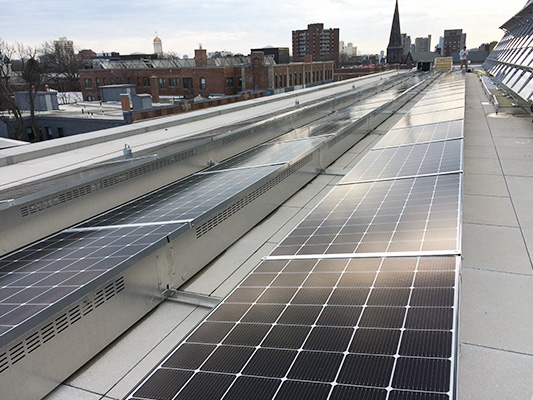About halfway through the installation of solar panels on the Harvard Art Museums’ roof, Mother Nature intervened with a little practical joke: it snowed.
“The first thing the installers had to do this morning was shovel,” said Mike Eigen, facilities manager, on the Monday after a weekend storm. It took about an hour of shoveling to remove the snow that had settled on the building’s fourth-floor roof, but afterward the installers were able to quickly resume their regularly scheduled work.
“Snow is something that we’re used to working in,” said Derek Brain, who led the installation by Solworks Energy, a Groton, Massachusetts—based company. “It’s wind that can be more of an issue.”
Fortunately, neither proved to be too much of an impediment, and the museums’ first solar panels were successfully installed and will be in operation by the end of February. It was an important step in the museums’ mission to achieve and maintain sustainable and environmentally friendly facilities.
“We’re trying to reduce our carbon footprint as an institution,” said Eigen, who has been leading the project to install the solar panels, along with Peter Atkinson, director of facilities planning and management, and assistant facilities manager Jason Barcus, in partnership with Harvard’s Green Building Services. The installation is part of a larger ongoing effort by the museums that has included streamlining air temperature and humidity controls, installing an all-LED lighting system, and implementing water conservation strategies.
It is also a meaningful action in support of the Harvard-wide effort to become smarter about and more proactive with regard to energy consumption. Since 2008, facilities, schools, and groups across Harvard have taken concrete steps such as these to pursue sustainability, with the announcement in late 2016 that Harvard had achieved its goal of reducing its greenhouse gas emissions by 30 percent. Work toward sustainability won’t end there, however, and the museums’ solar panel installation is just one indication of continued efforts.
Small but Significant
The new 29.61-kilowatt system of solar panels will help offset a portion of the museums’ electricity costs. The 94 panels are arranged in two rows on a 3,000 square foot array on the fourth-floor roof outside the Art Study Center. (Due to the building’s unique architectural facade and sloped glass roof, only a relatively small proportion of the building’s roof can support solar panels.)
The panels aren’t noticeable unless a visitor is specifically looking for them from within the Art Study Center. Still, museums staff and Solworks employees worked hard to make sure that the panels and racks complemented the building’s unique aesthetic developed by world-renowned architects at the Renzo Piano Building Workshop. “Even though the panels are not prominently visible, we still wanted them to look the part with modern, clean lines,” Eigen said. “What we have now both works well and looks good.”
It was key, also, for the panels to be optimally positioned on the roof relative to the Straus Center for Conservation and Technical Studies. With laboratory and office spaces located on the fourth and fifth floors of the building, parts of the Straus Center are within sight of the racks. Thus, “it was important to avoid having the panels create any glare for the conservators,” Brain said.
With the panels now completely, and discreetly, in place, the museums are even more capable of maintaining energy efficiency and sustainability—no matter what the weather throws at us.




